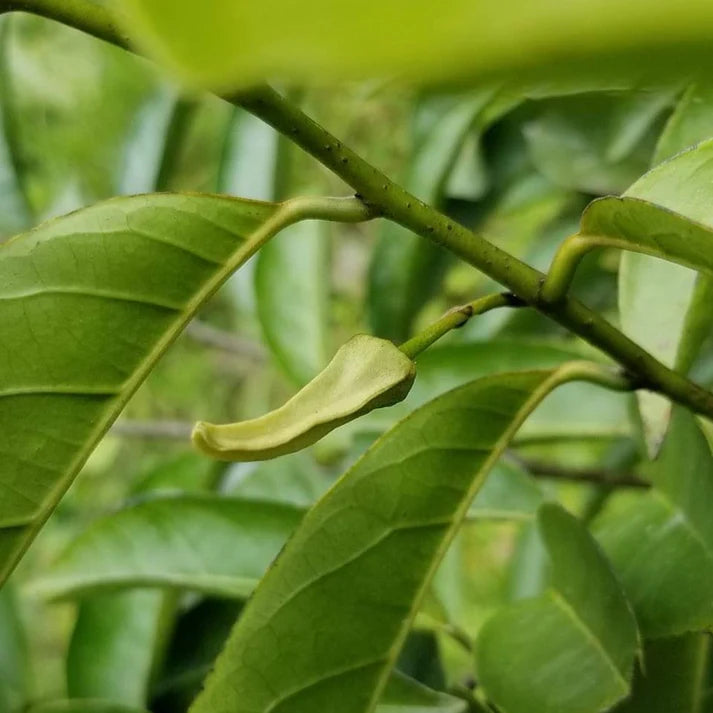Love it? Add to your wishlist
Your favorites, all in one place. Shop quickly and easily with the wishlist feature!
[message]
[title]
[message]


Veliyath Gardens
Couldn't load pickup availability
Annona quinduensis – A Rare Andean Delight with Healing Essence and Lush Flavor
Botanical Name: Annona quinduensis
Common Name: Annona Quinduensis
From the misty tropical highlands of Colombia and Ecuador, Annona quinduensis emerges as a botanical treasure rarely seen in mainstream horticulture. Belonging to the cherished Annonaceae family, this exotic fruit plant is not just admired for its juicy, melting-textured fruits, but is also valued for its ties to traditional medicine and cultural symbolism. Named after the Quindío region by renowned botanist Carl Sigismund Kunth, this plant invites garden lovers and health seekers alike to experience a piece of Latin American herbal heritage in their own soil.
Scientific Classification: A lesser-known yet important species within the Annonaceae family.
Naming History: The name Annona quinduensis honors Quindío, a region in the western Andes of Colombia, known for its lush cloud forests and biodiversity.
Native Range: Thrives in the humid tropical zones of Colombia and Ecuador, often spotted in low- to mid-elevation woodlands and forest clearings.
Growth Form: A shrub to small tree, with broad green foliage and a gentle growth rhythm that suits tropical and subtropical climates.
Appearance: Fruits resemble other Annona species in form, with a soft outer covering and round to slightly oblong shape.
Texture: The flesh is tender, juicy, and melts in the mouth, making it extremely appealing for fresh eating.
Taste Notes: Rich in natural sweetness with subtle floral undertones. Often compared to custard apples but more delicate in texture.
Consumption: Traditionally enjoyed fresh, straight from the fruit or scooped into desserts and beverages.
A perfect addition to fresh fruit platters, fruit salads, and tropical smoothies.
The silky consistency and mild sweetness make it ideal for natural desserts, fruit bowls, and wellness snacks.
The fruit is also appreciated for its aromatic appeal, often used in local kitchen traditions to flavor puddings or herbal syrups.
In South American home gardens, this fruit is offered to guests as a symbol of warmth and health.
Though specific scientific studies on Annona quinduensis are limited, its close relation to Annona muricata (soursop) gives context to its traditional uses:
Leaves
Brewed as herbal teas to relieve headaches, promote better sleep, and calm urinary discomfort such as cystitis.
In folk medicine, the leaf infusion is also associated with cancer support regimens, especially in rural Andean regions.
Seeds
Crushed and used cautiously to treat parasitic infections and cleanse the digestive tract.
Fruit Pulp
Administered for relieving diarrhea, easing neuralgia, and boosting lactation in new mothers.
Used to reduce fevers and help in general convalescence, especially in tropical climates where herbal remedies are preferred over pharmaceuticals.
Though detailed nutritional breakdowns are not widely published, related species suggest that Annona quinduensis is likely to be:
Rich in dietary fiber, aiding digestion and supporting bowel regularity
Contains natural sugars and essential minerals like potassium, calcium, and trace magnesium
Potential source of Vitamin C and antioxidants, offering immune-strengthening properties
Anti-inflammatory effects from bioactive compounds found in both fruit and leaves
May contribute to hormonal balance, particularly for lactating women or those recovering from illness
In Colombian and Ecuadorian households, fruits like Annona quinduensis are deeply woven into the rhythm of seasonal harvests.
Often presented during family gatherings and used in traditional medicine passed from elder healers to younger generations.
In local beliefs, planting such species near homes is associated with protection and fertility.
The fruit is also seen as a harbinger of wellness, shared during illness recovery or postpartum care.
Growth Habit: Slow to moderate; ideal for tropical and sub-tropical climates.
Height: Can grow as a shrub or a small tree, depending on soil and environment.
Fruiting Time: Typically begins flowering and fruiting within 2 to 3 years when given appropriate care.
Sunlight: Thrives in full to filtered sunlight with regular warmth and humidity.
Watering: Requires consistent moisture but well-drained soil; avoid waterlogging.
Soil Needs: Prefers light, humus-rich soils with good aeration and slight acidity.
Maintenance: Moderate; includes light pruning, mulching, and occasional organic feeding.
Container Friendly: Can be cultivated in large pots, making it accessible for home gardeners with limited ground space.
Harvesting: Best picked when the skin softens slightly and emits a mild fragrance.
Shelf Life: The fresh fruit is best enjoyed within 2 to 3 days of ripening.
Storage: Can be refrigerated short-term; pulp can be scooped and frozen for future use in smoothies or herbal infusions.
Seed Collection: Clean seeds thoroughly before drying; store in cool, dry conditions for future planting.
A graceful addition to any exotic fruit garden, especially for those drawn to healing plants and natural wellness.
Its fruit can become a regular part of your diet for digestion and energy.
Create soothing herbal teas with the leaves, especially during stress or seasonal fatigue.
Involve children and family in harvesting and tasting, making it part of a wholesome garden experience.
Ideal for those who value sustainable, self-grown health foods with cultural depth.
At Veliyath Gardens, we bring to you not just a plant, but a cultural and botanical legacy. With careful sourcing, healthy propagation, and a passion for rare species, we offer Annona quinduensis to the discerning grower who seeks more than just fruit—but nourishment for body and tradition. This plant reflects our commitment to healing plants, edible landscapes, and rare green treasures.
Conclusion
Annona quinduensis, though quiet in its fame, carries the gentle strength of traditional healing, the sweetness of rare fruit, and the rooted grace of Colombia’s mountain regions. With its tender pulp, medicinal values, and easy maintenance, this fruit plant is an ideal companion for conscious gardeners, home healers, and exotic plant collectors.
Grow Annona quinduensis with purpose. Let your garden speak the language of health and heritage—only from Veliyath Gardens.
Fruiting Time: Typically begins flowering and fruiting within 2 to 3 years when given appropriate care.
Sunlight: Thrives in full to filtered sunlight with regular warmth and humidity.
Watering: Requires consistent moisture but well-drained soil; avoid waterlogging.
Rich in dietary fiber, aiding digestion and supporting bowel regularity
Contains natural sugars and essential minerals like potassium, calcium, and trace magnesium
Potential source of Vitamin C and antioxidants, offering immune-strengthening properties
A perfect addition to fresh fruit platters, fruit salads, and tropical smoothies.
The silky consistency and mild sweetness make it ideal for natural desserts, fruit bowls, and wellness snacks.
The fruit is also appreciated for its aromatic appeal, often used in local kitchen traditions to flavor puddings or herbal syrups.



